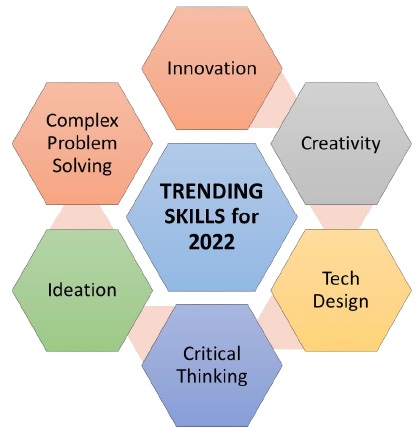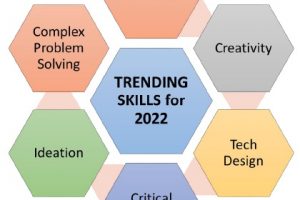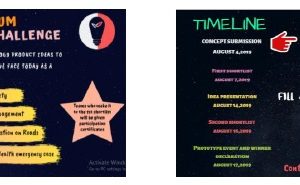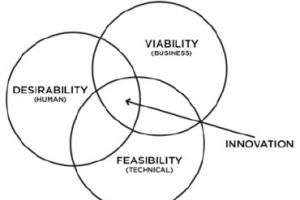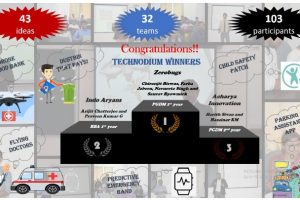– Anshu Sharma
Innovation: The Future of Jobs Imperative
“Innovation” has been identified as the Number 1 trending skill for 2022 by World Economic Forum in their Future of Jobs report 2018. Along with innovation, thinking based higher order skills such as Creativity, Complex Problem Solving, Ideation, Critical Thinking and Technology Design have found place amongst the top 10 trending skills for 2022.
With this perspective it had become imperative that we at ISME give our students due exposure which helps them develop these skills. With this intent, a Design Thinking & Innovation course was floated as an elective for PGDM 2nd year students.
Design thinking was an obvious choice to anchor this innovation based course not just because of its relevance in today’s world but also because of it emerging as one of the sought after skill set in the industry today.
“Design Thinking is a human-centered approach to innovation that draws from the designer’s toolkit to integrate the needs of people, the possibilities of technology, and the requirements for business success.”
– Tim Brown, CEO of IDEO, A leading Design Thinking firm
Twin Outcomes
As a faculty for this course, my vision was that at the end of this course students should be able to achieve the following twin outcomes:
1. Use design thinking approach at an individual level to find innovative solutions for
complex human centered problems
2. Manage the innovation funnel for their organization – from idea generation to idea
filtering, prototyping, testing and implementation
In order to make this course as experiential in nature as possible, I floated the idea of “Technodium: An Innovation Challenge”. This was supposed to be an intra-college innovation challenge of the students, by the students and for the students. My DT&I class comprising of 19 students was not only supposed to organize this event but also participate in this event like other regular participants. This dual role I believe will help me achieve the twin outcomes that I had set out for.
Finalizing the Challenges for Innovation
As a first step, the DT&I class came up with a list of 4 problem areas which were to be posted as challenges for the competition. The entire class was divided into four groups and each group came up with a challenge that they would want to focus on. The design thinking approach is more conducive to problems which are complex, have multiple possible solutions, there is ambiguity on the root causes of the problem and most importantly have a strong human connect. Hence, we focussed on some of the most critical problems that we face today as a society. As a result, following were the four challenges identified by the class for the competition:
1. Enhancing Child Safety
2. Improving Waste Management
3. Reducing Traffic Congestion on Roads
4. Accelerating Response in Health Emergency Cases
From here on, there were two broad work-streams in motion for the DT&I class:
1. As innovation process managers – organizing the innovation challenge and managing the idea funnel
2. As innovators – working in groups on their respective challenges
The 5-Phase Event
The event was organized across five milestones from 4th Aug to 17th Aug 2019:
1. Concept Submission
2. Fist Shortlist
3. Idea Presentation
4. Second Shortlist
5. Prototyping Event and Declaration of Winners
A poster designed by the poster team was put up across the ISME campus inviting idea submissions. Attractive prizes of INR 4,500 were announced to motivate participation. It was important to generate a high number of ideas in order to give the class a feel of managing an idea pipeline in a real life scenario.
Teams of up to 5 students were encouraged to participate by choosing one or more of the four challenges and submitting a brief concept note for a technology based solution which is feasible and economically viable. Participants could submit concept note of their ideas by just scanning a QR code printed on the poster.
Weak initial participation
Initial few days, post the event launch, saw a weak trickle of participation with very few ideas coming in the first few days. We were targeting a number of 100 participants from a student body of close to 300 students. Anything less than 50 ideas will not have given my class a good enough exposure of managing an innovation funnel. As participation was becoming a concern, we decided to reach out to different student groups and forums within ISME directly and encourage students to participate. We used forums such as classes, clubs and labs to further push participation from students. We also got the program HODs on board to drive our message around the students. This helped us gain some traction.
Finally, after a couple of days of hectic direct marketing efforts across various platforms we managed to receive a total of 43 ideas from 32 teams with a participation of 103 students in total. We were slightly short of our target, but were good to go.
Having myself run similar innovation campaigns in multinational corporates, I have come to realize that it really takes significant internal marketing to get people out of their regular day job and make them think of an innovative idea. Some of them see it just as a gimmick and some see it as a waste of their precious time. Hence, it is important that such programs are driven from the very top. Unless the CEO is seen as the main sponsor of the program, it is bound to fizzle out very soon. I was glad that my DT&I class got to experience this first hand.
Traversing the Innovation Funnel
The 43 ideas that we received went through rigorous filtering criteria centered on the three key tenets which form the innovation sweet spot: Desirability, Viability and Feasibility.
The class used concepts of design thinking to devise objective filtering criterion to score each idea across these three parameters. The 1st filtering was done solely on the Desirability aspects while the 2nd filtering done post the presentation round was based on technical feasibility and business viability metrics. This is where my DT&I class got their first exposure of the filtering and decision making process.
They had to keep their biases aside while objectively evaluating ideas submitted by their closest of friends or darkest of foes. They also had to arrive at a consensus amongst each other in case of conflicting viewpoints during the idea filtration process. This was a good learning process for them, as this tested their decision making and pushed them to come up with objective ways for managing conflicting viewpoints.
The next step, once the 2nd shortlist was out, was the prototyping event.
Scheduling Challenges
In a typical traditional organization, innovation is not the top agenda for any department. Even some of the progressive organizations have separate innovation teams whose agenda is to keep working on some or the other innovation project in silos without them being part of the mainstream. This results in innovation based activities typically getting deprioritized down the value chain. I am glad that the students also got a flavour of the same. The student calendar was full with classes, club activities, lab events and other regular curricular and extra-curricular activities. To make things worse, the 32 participating teams comprised of students from different years, different courses, different specializations and different sections. This made the task of scheduling Technodium activities a living nightmare. It was becoming impossible for us to find a slot where all the 32 teams are available.
The organizing teamed hustled to find multiple slots for the presentation round. We organized 13 presentations across 4 to 5 different time slots depending on team availability. While this was ok in case of team presentations, this would not have worked for the prototyping event which was supposed to be one gala event where all teams worked together to build their respective prototypes. Hence, we had to cancel the prototyping event, and declare the winners at the end of the presentation round itself.
While this was a minor setback for us, it gave my DT&I class another key lesson in innovation process management.
Conclusion
This was our first experiment at ISME of conducing a completely activity based Design Thinking & Innovation class. When I look back at my twin objectives, I believe I managed to achieve both successfully. I am confident that the students while working as participants learned the art and science of innovation. Also, while acting as organizers they learned the nuances of managing an end-to-end innovation process. This adds a significant skill-set to their repertoire especially in this fast changing disruptive economy where innovation is going to be the most sought after skill.
Questions
1. Conduct an objective evaluation of the construct of Technodium and suggest improvement options.
2. How could the organizing committee have avoided the scheduling challenges faced?
3. What led to the cancellation of prototyping event? How would you have done it differently?
4. What are the key learnings students derived out of organizing the innovation challenge?
DISCLAIMER: The views, opinions and content on this blog are solely those of the authors. ISME does not take responsibility of content which are plagiarised or not quoted.



